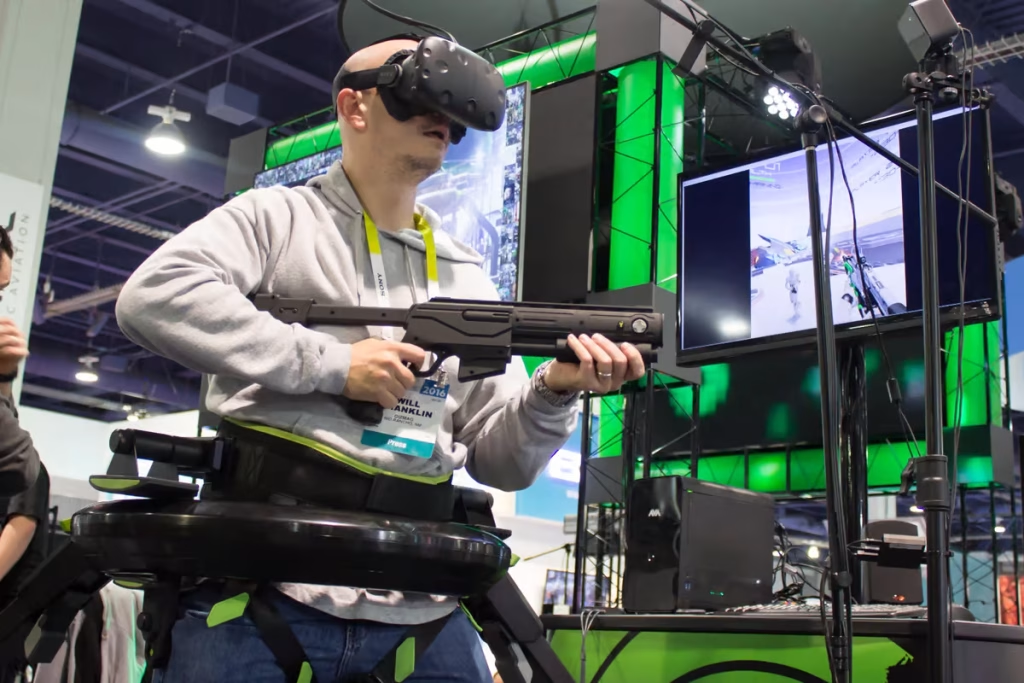The revolutionary VR technology of 2025. Learn how OmniVR works, its applications, and why it’s transforming the virtual reality landscape.
Table of Contents
Introduction to OmniVR
OmniVR is a next-generation virtual reality platform that combines advanced hardware, software, and AI to create a fully immersive and interactive experience. Unlike traditional VR systems, which often rely on handheld controllers or limited motion tracking, OmniVR integrates full-body motion capture, haptic feedback, and environmental interaction to blur the line between the physical and virtual worlds.
The name OmniVR is derived from its omnidirectional capabilities, allowing users to move freely in any direction within a virtual space. This technology is designed to cater to a wide range of industries, from gaming and entertainment to education, healthcare, and beyond.
How Does OmniVR Work?

At its core, OmniVR is built on three key pillars: motion tracking, haptic feedback, and AI-driven environments. Let’s break down each component:
1. Motion Tracking
OmniVR uses a combination of sensors, cameras, and wearable devices to track the user’s movements with pinpoint accuracy. Whether you’re walking, running, or even jumping, the system captures every motion and translates it into the virtual world in real-time. This eliminates the need for external controllers, making the experience more intuitive and natural.
2. Haptic Feedback
One of the standout features of OmniVR is its advanced haptic feedback system. Users can feel textures, impacts, and even temperature changes through specialized gloves, suits, and footwear. This tactile feedback enhances immersion, making virtual interactions feel incredibly real.
3. AI-Driven Environments
OmniVR leverages artificial intelligence to create dynamic and responsive virtual environments. The AI adapts to the user’s actions, creating a personalized experience that evolves in real-time. For example, if you’re exploring a virtual forest, the AI might generate wildlife or weather changes based on your movements and decisions.
Applications of OmniVR

The versatility of OmniVR makes it applicable across various industries. Here are some of the most exciting use cases:
1. Gaming and Entertainment
Gaming is one of the primary drivers of VR technology, and OmniVR takes it to the next level. Imagine stepping into a virtual battlefield where you can physically dodge bullets, feel the recoil of a weapon, and interact with your surroundings. The level of immersion offered by OmniVR is unmatched, making it a game-changer for the gaming industry.
2. Education and Training
OmniVR is also transforming education and training. Medical students can practice surgeries in a risk-free virtual environment, while engineers can simulate complex machinery operations. The haptic feedback system ensures that users gain hands-on experience without the need for physical equipment.
3. Healthcare
In healthcare, OmniVR is being used for physical therapy, mental health treatment, and even surgical planning. Patients can engage in virtual exercises that are tailored to their needs, while therapists can monitor progress in real-time.
4. Real Estate and Architecture
Architects and real estate agents are using OmniVR to create virtual tours of properties and designs. Clients can walk through a virtual home or building, experiencing the space as if they were physically there.
5. Social Interaction
With OmniVR, social interactions in virtual spaces are more lifelike than ever. Users can attend virtual meetings, concerts, or even family gatherings, complete with realistic avatars and environmental interactions.
Why OmniVR Stands Out

What sets OmniVR apart from other VR technologies is its holistic approach to immersion. While traditional VR systems focus on visual and auditory experiences, OmniVR incorporates touch, movement, and environmental interaction to create a truly multisensory experience. Additionally, its AI-driven environments ensure that no two experiences are the same, making it highly engaging and personalized.
The Future of OmniVR

As we look ahead, the potential for OmniVR is limitless. With ongoing advancements in AI, haptics, and motion tracking, the technology is expected to become even more sophisticated. Industry experts predict that OmniVR will play a key role in shaping the metaverse, a collective virtual shared space that is gaining traction in 2025.
Moreover, as the cost of OmniVR hardware decreases, it will become more accessible to the general public, further driving its adoption. From gaming and entertainment to education and healthcare, OmniVR is set to redefine how we interact with virtual worlds.
FAQs About OmniVR
1. What makes OmniVR different from other VR systems?
OmniVR stands out due to its full-body motion tracking, advanced haptic feedback, and AI-driven environments, which together create a highly immersive and interactive experience.
2. Can OmniVR be used for professional training?
Yes, OmniVR is ideal for professional training in fields like healthcare, engineering, and aviation, offering realistic simulations and hands-on practice.
3. Is OmniVR compatible with existing VR content?
While OmniVR is designed to work with its proprietary hardware and software, efforts are being made to ensure compatibility with existing VR content.
4. How much does OmniVR cost?
As of 2025, OmniVR systems are priced at a premium due to their advanced features. However, prices are expected to decrease as the technology becomes more widespread.
5. What industries can benefit from OmniVR?
OmniVR has applications in gaming, education, healthcare, real estate, architecture, and social interaction, among others.
Conclusion
OmniVR is more than just a VR system; it’s a gateway to a new dimension of interaction and immersion. By combining cutting-edge motion tracking, haptic feedback, and AI, OmniVR is setting a new standard for virtual reality in 2025. Whether you’re a gamer, educator, healthcare professional, or simply a tech enthusiast, OmniVR offers something for everyone. As this technology continues to evolve, it’s clear that OmniVR is not just the future of VR—it’s the future of how we experience the world.




